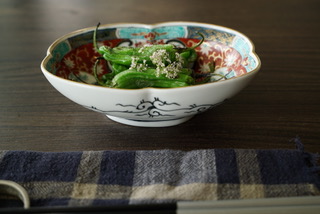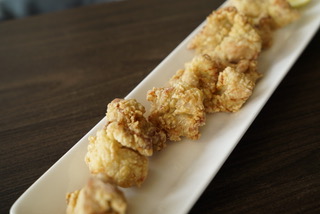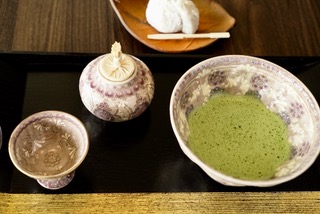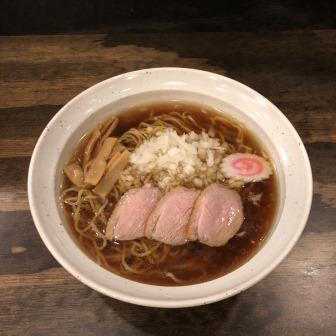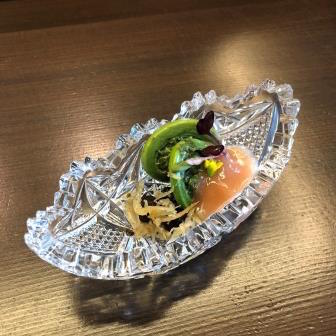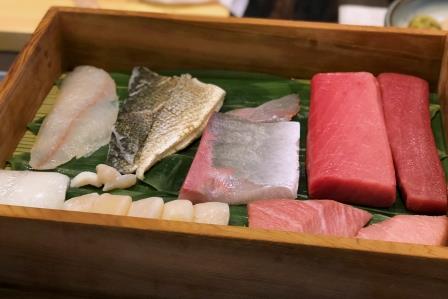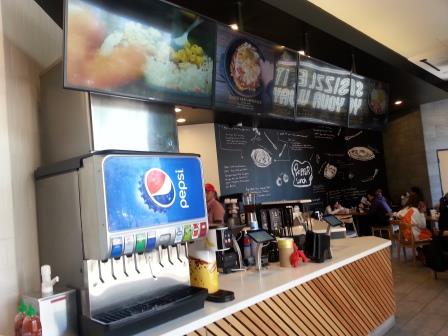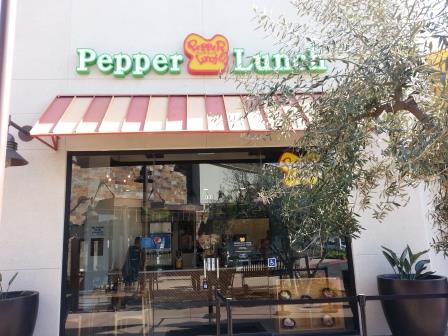Ramen Saryo Hachi Quality-first ramen, as if it were a Kappo dish, Ramen Saryo Hachi is enjoyed in a tea salon room-like place
By Elli Sekine
In a corner of a shopping center in the suburbs of San Francisco, there is a café decorated with flowers and plants, looking like a café on a street of a French town. Comforting Ghibli movie tunes are played inside the restaurant. Believe it or not, it is a ramen restaurant. Unlike the preconceived masculine image, there are things you usually wouldn’t expect to see in a ramen restaurant such as flower arrangements, high-quality green tea and cups from Kyoto, cans of Mariage Frères tea, hand-made macarons, etc. The staff members are all women. “Ramen Saryo Hachi”, where Kyoto style ramen with particularly-selected ingredients is served in a “tea ceremony room” style, was opened at the end of last year.
The owner/chef, Yuko Nammo, has been living in the US for the past 20 years. This is the first restaurant she runs; however, her career as a cook is very long. She has been building her career while researching and studying in the Bay Area, working for the first-class Kaiseki cuisine restaurants.
In the process, the current head chef of a Michelin-starred restaurant, and the former head chef of “Kagetsu” became her partner, and now is involved in this business as the director. “Kyoto style ramen” to her, is chicken stock base and light taste, in which the core tastes of the ingredients are well presented. She wanted to replicate the old-fashioned simple ramen, the whole soup of which can be drunk up. They don’t make the taste strong, nor add a whole bunch of toppings just to suit the preferences of Americans. “I would like the customers just to taste the chicken stock base soup prepared with the utmost care, “says Nammo-san.
There are 3 items in the menu; Shoyu OnTama TORI-ffle Ramen, Tori Paitan Pork Chashu Ramen, and Vegetarian Ramen. Egg toppings such as OnTama or AjiTama, and Shinachiku (bamboo shoots), and small amounts of vegetables are added to the soup. I had the signature dish first, which is the Shoyu OnTama TORI-ffle Ramen. The broth tasted not complex, but simple, yet deep. It is not rich and oily as it usually is, and can be drunk up as a tasty soup, It does not feel too heavy even if you finish the whole thing, and feels as though it gets absorbed nicely into your body. Chicken Charshu, which is the breast meat cooked by the sous vide method, is juicy and tender. Everything compliments each other well, as well as the thin noodles. OnTama is cooked so lightly boiled that you can see through the yolk, so you could also mix it together with the soup to eat together, if so preferred. The number of menu items is few, but they don’t dare make it look complicated, or explain it in detail. ”I don’t think it is necessary to explain things that are already delicious. What I care about the most is not to miss the peak of ingredients to be cooked,” says she, who approaches ramen like a topnotch
chef with a strong will.
To Nammo, the selecting of ingredients comes first. They use the same grade ingredients as any high-class restaurant. Chicken, the main ingredient, is free-range chicken raised sustainably in the Petaluma region, and organic chicken of a different brand, which are preordered. The eggs are free-range chicken eggs, and the vegetables are mostly organic. Some of the food cost is as high as 50%.
Blood is cleaned off of torigara (chicken bones and other parts) for making clear and rich Paitan soups, and frozen on the same day of delivery. Nammo-san explains the reason for freezing while still fresh as follows: “We do it to make it possible to avoid any unwanted smell, and bring out the maximum umami.” After defrosting, it is grilled with onions and other vegetables, and simmer-cooked well for 3 to 4 hours. The best umami of the ingredients cannot be brought out if cooked for too little time, or too long, so you need to judge the best timing as you cook by constantly checking the condition. Her philosophy about cooking –“whether you can bring the best of umami, or kill it, depends on cooking temperature adjustment and length of cooking time,”– is close to that of the level of Kaiseki-style cuisine.
Other menu items, such as Karaage, and Sweet Shishito, are delicate and presented beautifully. Their “tea ceremony room”-like particularity is also reflected in their serving dishes.
Their drink menu has a unique lineup, considering good pairings with ramen. Examples are craft Sansho beer, and various Kyoto beers, which are rarely seen anywhere else. They also carry a high-class lineup of drinks such as Napa’s “Kistler” brand wines for wine connoisseurs. As for soft drinks, you can order Sencha and Gyokuro of Kyoto Ippodo, and ceremonially prepared matcha served in Uji Koyamaen’s cup. It is nice that they have a rich variety of desserts such as matcha desserts and house-made macarons thanks to having a pastry chef at all times.
Why ramen? I asked Nammo-san the reason for choosing ramen over Kaiseki, even though she possesses the technique of Kaiseki cuisine. She said that not only the fact that the establishment she succeeded was a ramen restaurant, but also the fact that she loves ramen, and wanted to pursue her ideology. She says, “The basic idea—bringing out the maximum umami of ingredients—can be applied to either Kaiseki or ramen. If you make ramen with great care, a bowl of ramen can be a healthy gourmet food.” After knowing how much care is put into the cooking, the price for a bowl, $14, seems very reasonable. “Ramen Saryo” is a rare restaurant in the Bay Area, where you can taste high-end values reasonably.
まるで割烹。品質本位の茶寮で味わうラーメン
サンフランシスコ郊外にあるショッピング施設構内の一角に、まるでフランスの路地にあるような花と緑が飾られた小さなカフェがある。店内からは心地よいジブリ音楽が流れている。なんと、ここはラーメン店。今までの男性的なイメージとは違い、生け花や京都の銘茶と茶器、マリアージュ紅茶の缶や手作りマカロンなど、ラーメン店らしからぬものがある。従業員は全員女性。食材にこだわった京風なラーメンを「茶寮」スタイルで提供する、「Ramen Saryo Hachi」が去年の暮れにオープンした。
オーナーシェフ、南茂祐子氏は在米生活20 年。同店が初めての経営となるが、料理人としての経歴は長い。ベイエリアで一流の会席料理店に勤めながら研究と実績を重ねて来た。その過程でパートナーとなった元「桂月」で現在サンフランシスコのミシュラン星レストランの料理長が今回ディレクターとして関与している。南茂氏にとって「京風ラーメン」とは、素材の味を生かした鶏ガラベースの優しい味。昔ながらのシンプルでスープが全部飲めるラーメンを再現したかったという。アメリカ人好みに味を濃くしたり何でもトッピングに加えたりしない。「あくまで丹念に仕込んだ鶏ガラスープを味わって頂きたい」と南茂氏。
メニューはしょうゆ味鶏チャーシュー付き、鶏白湯味豚チャーシュー付き、ベジタブルの3種類。具には温卵、味玉、シナチク、少々の野菜などが加わる。まず代表作である「鶏ラーメン」を賞味した。
ブロスはクリアで雑味がなく味に深みがある。ありがちなこってりした脂っぽさがないので、スープとして飲んでも美味しい。完食しても胃の負担はなく体に吸収されていく感覚だ。鶏チャーシューは胸肉を使用し真空調理法(通称:スーピー)で調理している為、ジューシーで柔らかい。全体的に細麺との相性も良い。
温卵は黄身の部分が透けて見えるくらいゆるいので、好みによってスープと混ぜて食べる事もできる。メニューの種類は少ないがあえて複雑にしたり説明をつけない。「美味しいものは説明する必要はないと思うのです。細心の注意を払っているのは、食材が持つピークの瞬間を見逃さずに調理する事です」とラーメンに向き合う姿勢は一流シェフの心意気だ。
南茂氏にとって食材選びは最優先で、高級店と同じ品質のものを使用している。メインとなる鶏はペタルマ地方のサステイナブル飼育のフリーレンジチキンと別ブランドからオーガニックチキンをプレオーダーをする。卵はオーガニックのフリーレンジチキン、野菜はほとんどがオーガニック食材でフードコストは50%に達する勢い。クリアと濃厚なパイタンスープに使う鶏ガラは仕入れたその日に血抜き処理をし即冷凍する。新鮮なうちに冷凍する理由について「臭みが全くなく最大限に旨味を引き出せる」と南茂氏。それをまた戻しネギや他の野菜とグリルしたのち3〜4時間かけて煮込む。それ以上でもそれ以下でも食材の旨味を引き出せないので、常に状態をみながらベストのタイミングを計らう。「食材の旨味を生かすも殺すも温度調整と加熱時間次第」という南茂氏の調理哲学は会席料理の域に近い。アペタイザーの唐揚げやスウィートシシトウなど他のメニューも繊細で盛り付けも美しい。また「茶寮」風こだわりは器にも表現されて
いる。
ドリンクメニューは、ラーメンとの相性も考慮し個性的なコレクションを揃えている。例えばクラフトビールでは山椒ビールや他店では見かけない京都ビール各種など。ワイン通の客にはナパの「キスラー」銘柄などの高級ラインもある。一方、ソフトドリンクは京都一保堂の煎茶や玉露、宇治小山園の茶碗で点てた抹茶も注文できる。ペストリーシェフが常勤している事で抹茶デザートや手作りのマカロン他デザートメニューも豊富なのも嬉しい。
会席料理の技術を持ち合わせている南茂氏にとって、どうしてラーメン店なのかと尋ねると、今回引き継いだ店舗がそうだったこともあるが、彼女もまたラーメン好きで自分の思想を貫きたかったという。「食材の持つ旨味を最大限に引き出すという基本は、会席もラーメン作りも変わらない。丁寧に作ればラーメンも健康的なグルメ食になる」と南茂氏。この調理の手間ひまを考慮すれば一杯$14 の価格はとても安く感じられる。
「Ramen Saryo」は、ハイエンドな価値をリーズナブルに味わえるベイエリアでも希少なレストランだ。
Ramen Saryo Hachi
1861 El Camino Real
Burlingame, CA 94010
(650) 239-9391
https://ramensaryo.com/
In a corner of a shopping center in the suburbs of San Francisco, there is a café decorated with flowers and plants, looking like a café on a street of a French town. Comforting Ghibli movie tunes are played inside the restaurant. Believe it or not, it is a ramen restaurant. Unlike the preconceived masculine image, there are things you usually wouldn’t expect to see in a ramen restaurant such as flower arrangements, high-quality green tea and cups from Kyoto, cans of Mariage Frères tea, hand-made macarons, etc. The staff members are all women. “Ramen Saryo Hachi”, where Kyoto style ramen with particularly-selected ingredients is served in a “tea ceremony room” style, was opened at the end of last year.
The owner/chef, Yuko Nammo, has been living in the US for the past 20 years. This is the first restaurant she runs; however, her career as a cook is very long. She has been building her career while researching and studying in the Bay Area, working for the first-class Kaiseki cuisine restaurants.
In the process, the current head chef of a Michelin-starred restaurant, and the former head chef of “Kagetsu” became her partner, and now is involved in this business as the director. “Kyoto style ramen” to her, is chicken stock base and light taste, in which the core tastes of the ingredients are well presented. She wanted to replicate the old-fashioned simple ramen, the whole soup of which can be drunk up. They don’t make the taste strong, nor add a whole bunch of toppings just to suit the preferences of Americans. “I would like the customers just to taste the chicken stock base soup prepared with the utmost care, “says Nammo-san.
There are 3 items in the menu; Shoyu OnTama TORI-ffle Ramen, Tori Paitan Pork Chashu Ramen, and Vegetarian Ramen. Egg toppings such as OnTama or AjiTama, and Shinachiku (bamboo shoots), and small amounts of vegetables are added to the soup. I had the signature dish first, which is the Shoyu OnTama TORI-ffle Ramen. The broth tasted not complex, but simple, yet deep. It is not rich and oily as it usually is, and can be drunk up as a tasty soup, It does not feel too heavy even if you finish the whole thing, and feels as though it gets absorbed nicely into your body. Chicken Charshu, which is the breast meat cooked by the sous vide method, is juicy and tender. Everything compliments each other well, as well as the thin noodles. OnTama is cooked so lightly boiled that you can see through the yolk, so you could also mix it together with the soup to eat together, if so preferred. The number of menu items is few, but they don’t dare make it look complicated, or explain it in detail. ”I don’t think it is necessary to explain things that are already delicious. What I care about the most is not to miss the peak of ingredients to be cooked,” says she, who approaches ramen like a topnotch
chef with a strong will.
To Nammo, the selecting of ingredients comes first. They use the same grade ingredients as any high-class restaurant. Chicken, the main ingredient, is free-range chicken raised sustainably in the Petaluma region, and organic chicken of a different brand, which are preordered. The eggs are free-range chicken eggs, and the vegetables are mostly organic. Some of the food cost is as high as 50%.
Blood is cleaned off of torigara (chicken bones and other parts) for making clear and rich Paitan soups, and frozen on the same day of delivery. Nammo-san explains the reason for freezing while still fresh as follows: “We do it to make it possible to avoid any unwanted smell, and bring out the maximum umami.” After defrosting, it is grilled with onions and other vegetables, and simmer-cooked well for 3 to 4 hours. The best umami of the ingredients cannot be brought out if cooked for too little time, or too long, so you need to judge the best timing as you cook by constantly checking the condition. Her philosophy about cooking –“whether you can bring the best of umami, or kill it, depends on cooking temperature adjustment and length of cooking time,”– is close to that of the level of Kaiseki-style cuisine.
Other menu items, such as Karaage, and Sweet Shishito, are delicate and presented beautifully. Their “tea ceremony room”-like particularity is also reflected in their serving dishes.
Their drink menu has a unique lineup, considering good pairings with ramen. Examples are craft Sansho beer, and various Kyoto beers, which are rarely seen anywhere else. They also carry a high-class lineup of drinks such as Napa’s “Kistler” brand wines for wine connoisseurs. As for soft drinks, you can order Sencha and Gyokuro of Kyoto Ippodo, and ceremonially prepared matcha served in Uji Koyamaen’s cup. It is nice that they have a rich variety of desserts such as matcha desserts and house-made macarons thanks to having a pastry chef at all times.
Why ramen? I asked Nammo-san the reason for choosing ramen over Kaiseki, even though she possesses the technique of Kaiseki cuisine. She said that not only the fact that the establishment she succeeded was a ramen restaurant, but also the fact that she loves ramen, and wanted to pursue her ideology. She says, “The basic idea—bringing out the maximum umami of ingredients—can be applied to either Kaiseki or ramen. If you make ramen with great care, a bowl of ramen can be a healthy gourmet food.” After knowing how much care is put into the cooking, the price for a bowl, $14, seems very reasonable. “Ramen Saryo” is a rare restaurant in the Bay Area, where you can taste high-end values reasonably.
まるで割烹。品質本位の茶寮で味わうラーメン
サンフランシスコ郊外にあるショッピング施設構内の一角に、まるでフランスの路地にあるような花と緑が飾られた小さなカフェがある。店内からは心地よいジブリ音楽が流れている。なんと、ここはラーメン店。今までの男性的なイメージとは違い、生け花や京都の銘茶と茶器、マリアージュ紅茶の缶や手作りマカロンなど、ラーメン店らしからぬものがある。従業員は全員女性。食材にこだわった京風なラーメンを「茶寮」スタイルで提供する、「Ramen Saryo Hachi」が去年の暮れにオープンした。
オーナーシェフ、南茂祐子氏は在米生活20 年。同店が初めての経営となるが、料理人としての経歴は長い。ベイエリアで一流の会席料理店に勤めながら研究と実績を重ねて来た。その過程でパートナーとなった元「桂月」で現在サンフランシスコのミシュラン星レストランの料理長が今回ディレクターとして関与している。南茂氏にとって「京風ラーメン」とは、素材の味を生かした鶏ガラベースの優しい味。昔ながらのシンプルでスープが全部飲めるラーメンを再現したかったという。アメリカ人好みに味を濃くしたり何でもトッピングに加えたりしない。「あくまで丹念に仕込んだ鶏ガラスープを味わって頂きたい」と南茂氏。
メニューはしょうゆ味鶏チャーシュー付き、鶏白湯味豚チャーシュー付き、ベジタブルの3種類。具には温卵、味玉、シナチク、少々の野菜などが加わる。まず代表作である「鶏ラーメン」を賞味した。
ブロスはクリアで雑味がなく味に深みがある。ありがちなこってりした脂っぽさがないので、スープとして飲んでも美味しい。完食しても胃の負担はなく体に吸収されていく感覚だ。鶏チャーシューは胸肉を使用し真空調理法(通称:スーピー)で調理している為、ジューシーで柔らかい。全体的に細麺との相性も良い。
温卵は黄身の部分が透けて見えるくらいゆるいので、好みによってスープと混ぜて食べる事もできる。メニューの種類は少ないがあえて複雑にしたり説明をつけない。「美味しいものは説明する必要はないと思うのです。細心の注意を払っているのは、食材が持つピークの瞬間を見逃さずに調理する事です」とラーメンに向き合う姿勢は一流シェフの心意気だ。
南茂氏にとって食材選びは最優先で、高級店と同じ品質のものを使用している。メインとなる鶏はペタルマ地方のサステイナブル飼育のフリーレンジチキンと別ブランドからオーガニックチキンをプレオーダーをする。卵はオーガニックのフリーレンジチキン、野菜はほとんどがオーガニック食材でフードコストは50%に達する勢い。クリアと濃厚なパイタンスープに使う鶏ガラは仕入れたその日に血抜き処理をし即冷凍する。新鮮なうちに冷凍する理由について「臭みが全くなく最大限に旨味を引き出せる」と南茂氏。それをまた戻しネギや他の野菜とグリルしたのち3〜4時間かけて煮込む。それ以上でもそれ以下でも食材の旨味を引き出せないので、常に状態をみながらベストのタイミングを計らう。「食材の旨味を生かすも殺すも温度調整と加熱時間次第」という南茂氏の調理哲学は会席料理の域に近い。アペタイザーの唐揚げやスウィートシシトウなど他のメニューも繊細で盛り付けも美しい。また「茶寮」風こだわりは器にも表現されて
いる。
ドリンクメニューは、ラーメンとの相性も考慮し個性的なコレクションを揃えている。例えばクラフトビールでは山椒ビールや他店では見かけない京都ビール各種など。ワイン通の客にはナパの「キスラー」銘柄などの高級ラインもある。一方、ソフトドリンクは京都一保堂の煎茶や玉露、宇治小山園の茶碗で点てた抹茶も注文できる。ペストリーシェフが常勤している事で抹茶デザートや手作りのマカロン他デザートメニューも豊富なのも嬉しい。
会席料理の技術を持ち合わせている南茂氏にとって、どうしてラーメン店なのかと尋ねると、今回引き継いだ店舗がそうだったこともあるが、彼女もまたラーメン好きで自分の思想を貫きたかったという。「食材の持つ旨味を最大限に引き出すという基本は、会席もラーメン作りも変わらない。丁寧に作ればラーメンも健康的なグルメ食になる」と南茂氏。この調理の手間ひまを考慮すれば一杯$14 の価格はとても安く感じられる。
「Ramen Saryo」は、ハイエンドな価値をリーズナブルに味わえるベイエリアでも希少なレストランだ。
Ramen Saryo Hachi
1861 El Camino Real
Burlingame, CA 94010
(650) 239-9391
https://ramensaryo.com/






